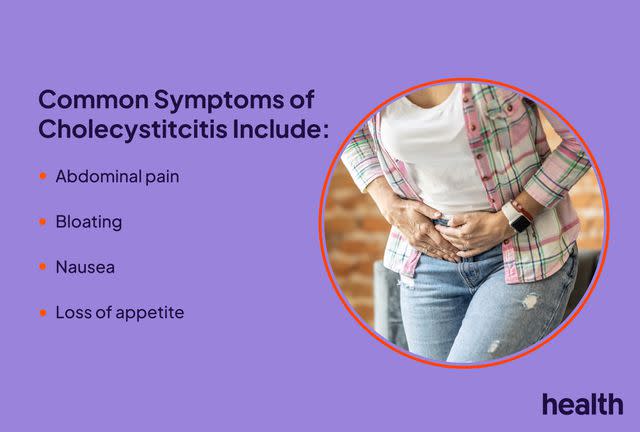Signs and Symptoms of Cholecystitis (Gallbladder Inflammation)
Medically reviewed by Jay N. Yepuri, MD
Cholecystitis is the inflammation and irritation of your gallbladder—the pear-shaped, digestive organ that sits beneath the liver, on the right side of your abdomen. This condition is often a complication of gallstones and occurs when bile (digestive fluid) can’t exit the gallbladder into the intestines properly. The buildup of bile can cause inflammation and lead to symptoms like abdominal pain and bloating.
This condition is often chronic (long-term) and often develops slowly. However, acute (short-term) cholecystitis symptoms can happen rapidly, which may be signs of a medical emergency. That said, it’s important to recognize the symptoms of this condition so you know when to get care from a healthcare provider.

Design by Health / Getty Images
Pain Symptoms
The primary sign of cholecystitis is abdominal pain. Everyone experiences pain differently, but common characteristics include pain that:
Is in the upper right abdomen
Is sharp or severe
Lasts for 30 minutes to several hours
Spreads to the middle back or below the right shoulder blade
Is duller, but lasts weeks
Occurs at night or after eating a meal
Worsens with deep breaths
Develops after eating fatty, greasy, or spicy foods
It's worth noting that symptoms of chronic cholecystitis can come and go. Sometimes you'll experience dull and steady pain for weeks and experience no symptoms at all at other times. However, acute cholecystitis causes sudden attacks of sharper, more severe stabs of pain.
For some, the pain can spread to the chest, which may feel so severe that it can feel like you're having a heart attack.
Digestive Symptoms
Cholecystitis also affects your ability to digest foods. Since bile helps your body break down fats, eating greasy or fatty foods can cause more buildup of bile and trigger inflammation. Alongside the abdominal pain, you may experience the following symptoms:
Bloating, especially after eating
Nausea and vomiting
Belching (burping)
Flatulence (farting)
Clay-colored stools
Dark-colored urine
Food intolerances, especially to fatty, greasy, or spicy foods
Loss of appetite
Other Symptoms
Several other symptoms can accompany pain and digestive problems with cholecystitis. These include:
Abdominal swelling
Fever
Headache
Sweating
Chills and shivering
Muscle weakness, pain, and stiffness
People older than 65 are less likely to experience pain and fever with this condition. This can make it difficult for healthcare providers to detect the condition early and offer treatment options. Unfortunately, older people are also at a higher risk of developing this condition, so it's important to seek care if you or a loved one develop symptoms that they're not normally experiencing.
Rare Symptoms
Without treatment, cholecystitis can become serious and sometimes cause fatal complications. It's worth noting that these complications are rare. However, complications like pancreatitis (pancreas inflammation), holes in the gallbladder, peritonitis (inflammation of the membrane that lines the abdomen), and trouble digesting food.
Symptoms of these complications include:
Rapid heart rate
Fever, chills, sweating
Headache
Stomach pain after eating
Appetite loss, unintentional weight loss
Fatty or greasy stools
Abdominal swelling
Increased thirst
Reduced urination, blood in the urine
Difficulty concentrating
When to Contact a Healthcare Provider
Acute cholecystitis warrants prompt medical attention and can be a medical emergency. Get immediate help if you experience any characteristic signs of a cholecystitis attack:
Sudden, sharp pain in the abdomen
Cramping that persists for several hours or more
Bloating
Nausea and vomiting
Persistent fever
Loss of consciousness or fainting
Contact your healthcare provider if you're experiencing symptoms despite getting treatment or developing signs of an infection.
Questions to Ask Your Provider
If you’re receiving care for cholecystitis, consider asking your healthcare provider the following questions:
What can I do to prevent cholecystitis?
What foods do you recommend I eat to keep symptoms at bay?
Which home remedies can help reduce my pain?
Will I need surgery to remove my gallbladder or are there other treatment options to improve symptoms?
A Quick Review
Cholecystitis occurs when your gallbladder becomes inflamed, causing attacks of severe pain in the upper right abdomen. In addition to pain, this condition leads to digestive symptoms, such as bloating, nausea, and gas. It can cause serious complications without treatment, so it's important to seek medical care if you develop symptoms.
Frequently Asked Questions
Is cholecystitis an emergency?
Acute cholecystitis can be a medical emergency. If you have symptoms like sudden and sharp pain, alongside nausea and fever, it's important to get medical care as soon as possible.
How long does a cholecystitis flare-up last?
Flare-ups of cholecystitis can last anywhere from several days to a few weeks. But with treatment, you should feel better within 2-3 days.
Can cholecystitis symptoms go away on their own?
Sometimes, cholecystitis symptoms subside and resolve without medical treatment. However, if your condition is occurring due to gallstones, symptoms can worsen over time. In those cases, surgery to remove the gallbladder can ensure the symptoms don’t come back.
For more Health.com news, make sure to sign up for our newsletter!
Read the original article on Health.com.

